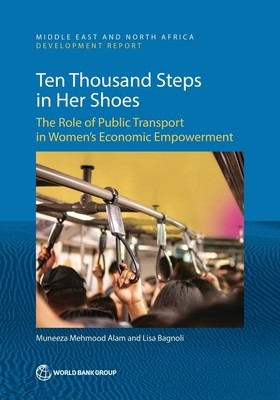
- We will send in 10–14 business days.
- Author: Muneeza Alam
- Publisher: World Bank Publications
- ISBN-10: 1464820910
- ISBN-13: 9781464820915
- Format: 17.3 x 25.2 x 0.8 cm, minkšti viršeliai
- Language: English
- SAVE -10% with code: EXTRA
Reviews
Description
In the Middle East and North Africa (MNA) region, women's university enrollment surpasses men's, yet their labor force participation (LFP) rate remains low and stagnant. What is preventing the women of MNA from translating their educational achievements into economic productivity? Is it a matter of personal preference, structural barriers, or both? This report sheds light on one of the structural barriers that may be preventing women from participating in the labor force--the public transport system. It focuses on the cities of Amman (Jordan), Beirut (Lebanon), and Cairo (Egypt) and uses primary data collected in 2022. The sources of the data are public transit mapping, built environment (safety) audits of public transit stops, public transport users' surveys, and household surveys. It finds that across all three cities, as compared to women, men are: (a) more mobile, (b) rely more on private vehicles, and (c) are more likely to hold driving licenses. In contrast, women are more dependent on male household members, taxis, or public transportation to meet their mobility needs. It identifies the challenges that women face when using public transit--these challenges differ by city. The main ones relate to uncomfortable and lengthy trips in Amman; road safety, costly and uncomfortable trips in Beirut; and lengthy and costly trips in Cairo. A large share of women expresses a" latent desire" to work but face transport related barriers. In each city, a large number of the interviewed non-working women state that the lack of affordable, comfortable, safe, time-efficient and reliable transport options is preventing them from looking for work. This corresponds to three in five women in Amman, one in two in Beirut, and two in five in Cairo. Statistical analysis confirms this by showing that a well-functioning public transport is crucial for enhancing women's LFP. Taken together, the findings of the report demonstrate that public transport affordability and accessibility are issues that are common to all three cities and need to be addressed. In addition, tailored concrete actions are needed in each city as explained in the report.
EXTRA 10 % discount with code: EXTRA
The promotion ends in 23d.02:23:42
The discount code is valid when purchasing from 10 €. Discounts do not stack.
- Author: Muneeza Alam
- Publisher: World Bank Publications
- ISBN-10: 1464820910
- ISBN-13: 9781464820915
- Format: 17.3 x 25.2 x 0.8 cm, minkšti viršeliai
- Language: English English
In the Middle East and North Africa (MNA) region, women's university enrollment surpasses men's, yet their labor force participation (LFP) rate remains low and stagnant. What is preventing the women of MNA from translating their educational achievements into economic productivity? Is it a matter of personal preference, structural barriers, or both? This report sheds light on one of the structural barriers that may be preventing women from participating in the labor force--the public transport system. It focuses on the cities of Amman (Jordan), Beirut (Lebanon), and Cairo (Egypt) and uses primary data collected in 2022. The sources of the data are public transit mapping, built environment (safety) audits of public transit stops, public transport users' surveys, and household surveys. It finds that across all three cities, as compared to women, men are: (a) more mobile, (b) rely more on private vehicles, and (c) are more likely to hold driving licenses. In contrast, women are more dependent on male household members, taxis, or public transportation to meet their mobility needs. It identifies the challenges that women face when using public transit--these challenges differ by city. The main ones relate to uncomfortable and lengthy trips in Amman; road safety, costly and uncomfortable trips in Beirut; and lengthy and costly trips in Cairo. A large share of women expresses a" latent desire" to work but face transport related barriers. In each city, a large number of the interviewed non-working women state that the lack of affordable, comfortable, safe, time-efficient and reliable transport options is preventing them from looking for work. This corresponds to three in five women in Amman, one in two in Beirut, and two in five in Cairo. Statistical analysis confirms this by showing that a well-functioning public transport is crucial for enhancing women's LFP. Taken together, the findings of the report demonstrate that public transport affordability and accessibility are issues that are common to all three cities and need to be addressed. In addition, tailored concrete actions are needed in each city as explained in the report.


Reviews